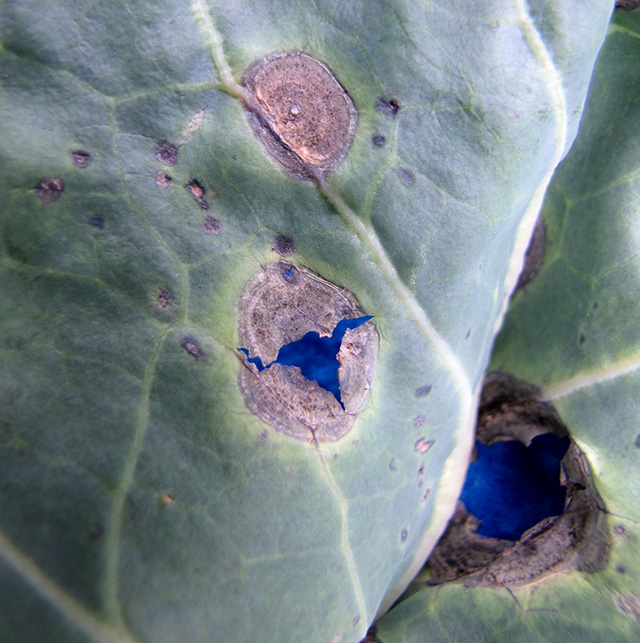This disease often occurs on Long Island starting in late summer where the pathogen is present and when conditions become favorable: cool and wet especially at night. Even during rain-free periods, over night in fall there often are long, heavy dew periods that provide conditions for infection by this and many other pathogens. The pathogen causing this disease grows best at 75 – 82 F; it does not grow below 46 F or above 97 F. Symptoms have been seen in spring when conditions were unusually favorable (extensive periods of rain). All cruciferous crops are susceptible.
Leaf spots are round, gray to black, small to as large as a quarter, and often have a target pattern. The spots may have a velvety appearance when the pathogen produces a lot of its dark spores. These spores are dispersed by wind, but typically do not move far because of their relatively large size compared to spores produced by powdery and downy mildew pathogens. Thus spread is rare among farms that are close but not adjacent. As leaf spots age they tend to become dry, papery and then tear.
This pathogen can survive in crop debris, thus it is important to disk affected crops as soon as possible after harvest. Breaking up crop debris into small pieces and incorporating it into the soil will hasten its decomposition. A 3-year rotation is ideal.
For management of Alternaria leaf spot in commercial crops, Bravo (chlorothalonil) is a good protectant fungicide. It has a 7-day pre-harvest interval (PHI). Targeted mobile fungicides for this disease include Endura (FRAC 7), Omega (29), Inspire Super (FRAC 3 + 9), Procure (FRAC 3), and Quadris or Cabrio (same chemical group; FRAC 11). PHI is 7 days for Inspire Super and 0 or 1 for the rest. Endura was most effective fungicide tested in some university trials. Switch is labeled but not permitted used on crops other than strawberry and onion on LI. FRAC 11 fungicides are recommended used sparingly, especially on farms where they have been used a lot in the past because resistance associated with poor control has been documented in other areas. The recommended program is an alternation among fungicide groups on a 7-day application schedule plus Bravo or a copper fungicide, if bacterial diseases are also occurring, included every week.
Please Note: Fungicides mentioned are for use in commercial production, not gardens. The specific directions on pesticide labels must be adhered to — they supersede these recommendations if there is a conflict. Any reference to commercial products, trade or brand names, is for information only; no endorsement is intended. For up-to-date information on labeled conventional fungicides see Cornell Integrated Crop and Pest Management Guidelines for Commercial Vegetable Production and biopesticides see the Biopesticides website.
Below: Symptoms of Alternaria leaf spot on leaf and petiole tissue of Brussels sprouts.
Below: Brown spots on the cauliflower head are due to Alternaria leaf spot.








